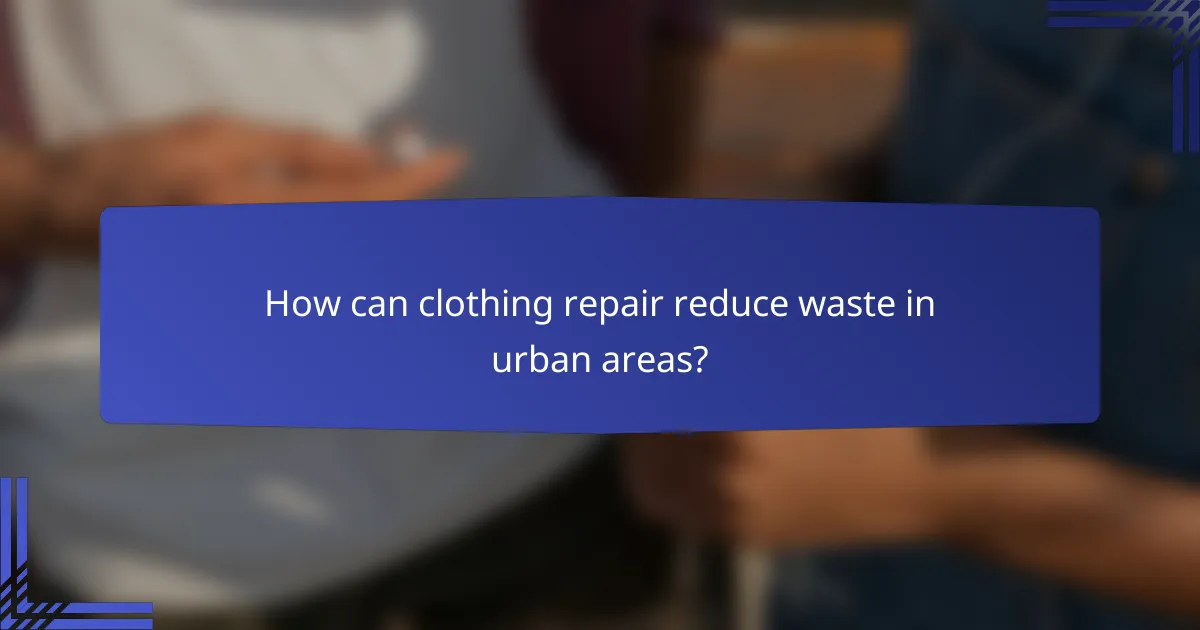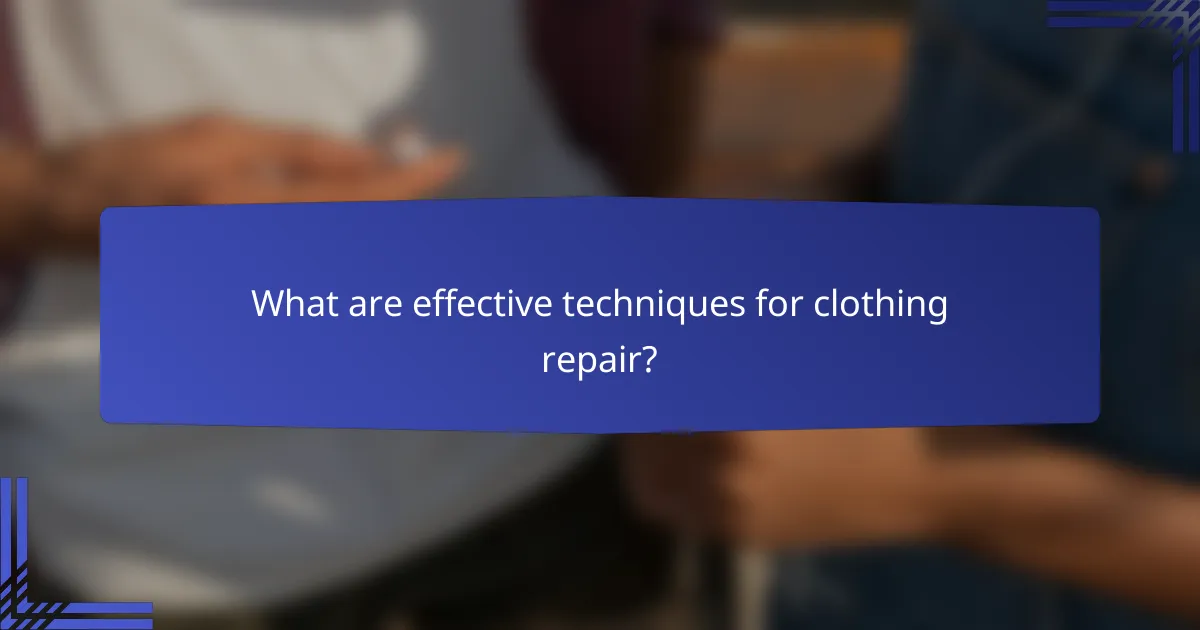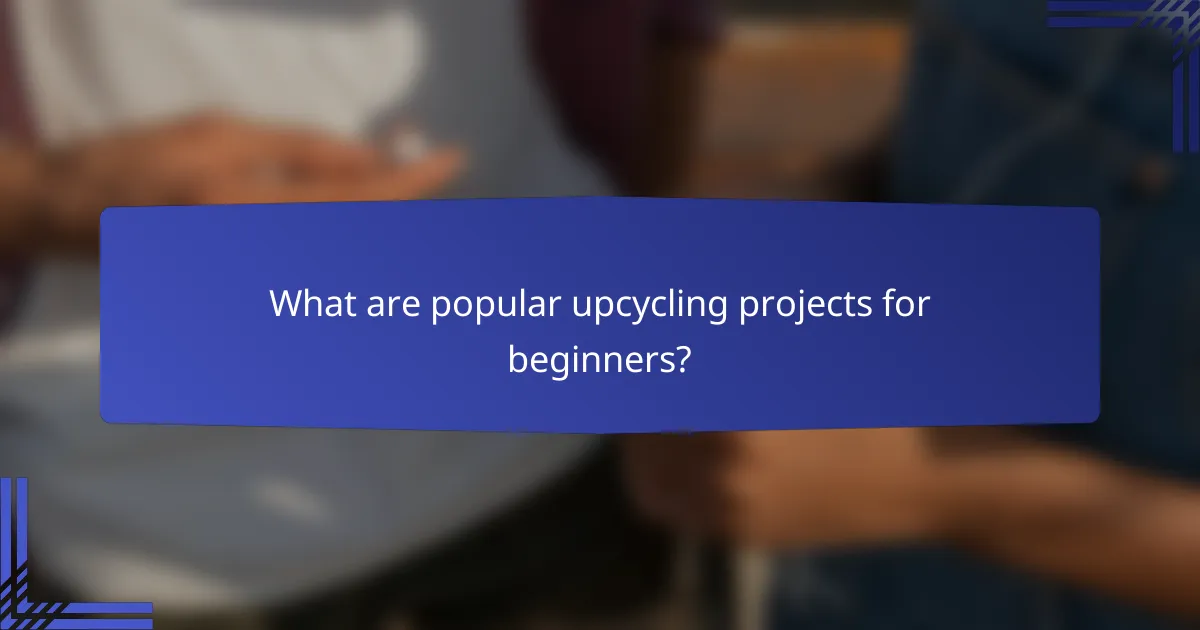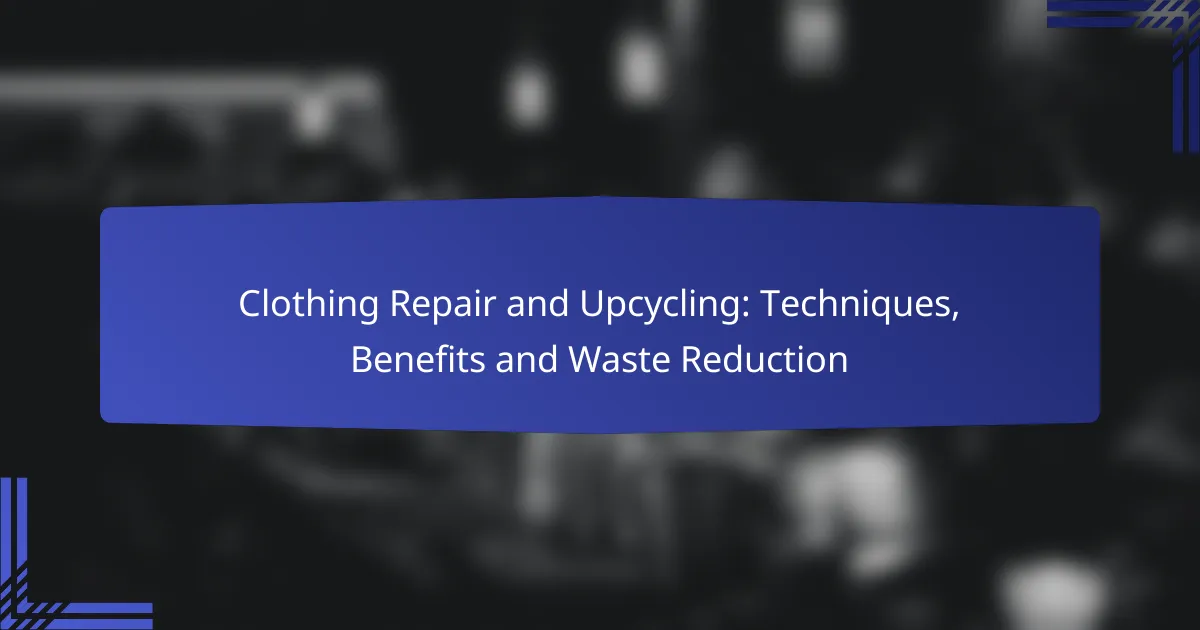Clothing repair and upcycling are essential practices that not only extend the life of garments but also play a crucial role in reducing textile waste. By employing techniques such as hand stitching, patchwork, and fabric glue, individuals can mend damaged clothing and create unique fashion items. This approach fosters a culture of sustainability, encouraging creativity while minimizing the environmental impact of discarded textiles.

How can clothing repair reduce waste in urban areas?
Clothing repair significantly reduces waste in urban areas by extending the life of garments and minimizing the volume of textiles sent to landfills. By encouraging individuals to mend their clothing rather than discard it, communities can foster a culture of sustainability and resourcefulness.
Repairing garments extends their lifespan
Repairing garments can add several years to their lifespan, allowing consumers to get more use out of their clothing. Simple fixes like sewing up a hem, patching a hole, or replacing a button can keep a favorite item in rotation much longer. This not only saves money but also reduces the need to purchase new items frequently.
Consider learning basic sewing techniques or utilizing local repair services. Many urban areas have community workshops or classes that teach these skills, making it easier for residents to engage in clothing repair.
Decreases landfill contributions
Clothing repair directly decreases the amount of textile waste that ends up in landfills. In urban settings, where waste management can be a challenge, every repaired garment means less material contributing to overflowing trash bins. Studies suggest that repairing just a fraction of discarded clothing could significantly lower landfill contributions.
To make a tangible impact, consider setting a personal goal to repair a certain number of garments each month. This small commitment can collectively lead to substantial waste reduction in your community.
Promotes sustainable fashion practices
Repairing clothing promotes sustainable fashion practices by shifting consumer attitudes toward valuing quality over quantity. When individuals prioritize mending over buying new, it encourages brands to adopt more sustainable production methods and materials. This shift can lead to a more responsible fashion industry overall.
Engaging in clothing repair can also inspire others in your community to adopt similar practices. Sharing your repair successes on social media or in local groups can create a ripple effect, encouraging a broader movement toward sustainability in fashion.

What are effective techniques for clothing repair?
Effective techniques for clothing repair include hand stitching, patchwork, and using fabric glue. Each method caters to different types of damage and can extend the life of garments while reducing waste.
Hand stitching for small tears
Hand stitching is ideal for repairing small tears in fabric. This technique involves using a needle and thread to sew the edges of the tear together, creating a strong and discreet repair.
When hand stitching, choose a thread that matches the fabric color to make the repair less noticeable. A simple running stitch or a backstitch can be effective for this purpose. Aim for stitches that are about 0.5 to 1 cm apart for durability.
Patchwork for larger damages
Patchwork is a creative solution for larger damages or holes in clothing. This technique involves sewing a piece of fabric over the damaged area, which not only repairs the garment but can also add a unique design element.
Select a patch that complements the original fabric, and ensure it is slightly larger than the damaged area. Use a straight stitch or zigzag stitch around the edges to secure the patch firmly. Consider using contrasting colors for a bold look or similar tones for a subtle repair.
Using fabric glue for quick fixes
Fabric glue is a fast and convenient option for quick repairs. It can be used to bond fabric pieces together without the need for sewing, making it suitable for small tears or hems.
When using fabric glue, apply a thin layer to the edges of the tear or the patch. Press the fabric together firmly and allow it to dry according to the manufacturer’s instructions, typically around 24 hours for a strong bond. Keep in mind that fabric glue may not be as durable as stitching for long-term repairs.

What are the benefits of upcycling clothing?
Upcycling clothing offers numerous advantages, including the creation of unique fashion items and a significant reduction in waste. By transforming old garments into new pieces, individuals can express their creativity while contributing to environmental sustainability.
Creates unique fashion pieces
Upcycling allows individuals to design one-of-a-kind clothing items that stand out from mass-produced fashion. By combining different fabrics or altering existing garments, you can create distinctive styles that reflect personal taste.
For example, turning an oversized shirt into a fitted dress or using scraps to make a patchwork bag can result in unique pieces that cannot be found in stores. This approach not only enhances your wardrobe but also promotes individuality in fashion.
Reduces environmental impact
Upcycling significantly lessens the environmental footprint associated with clothing production. By reusing materials, you help decrease the demand for new textiles, which often require substantial water and energy resources to produce.
Moreover, upcycling helps divert textiles from landfills, where they can take years to decompose. Engaging in this practice contributes to a circular economy, promoting sustainability and reducing waste in the fashion industry.
Encourages creativity and personal expression
Engaging in upcycling fosters creativity by encouraging individuals to think outside the box. It invites experimentation with colors, patterns, and designs, allowing for personal expression through fashion.
Whether you are sewing, dyeing, or embellishing, the process of transforming clothing can be a fulfilling creative outlet. It also provides an opportunity to develop new skills, making the act of upcycling both enjoyable and rewarding.

How to choose the right materials for upcycling?
Choosing the right materials for upcycling is crucial for ensuring durability, aesthetic appeal, and practicality. Consider factors like fabric durability, color compatibility, and the tools you have available to work with the materials.
Consider fabric durability
Fabric durability is essential for successful upcycling projects. Look for materials that can withstand wear and tear, such as denim, canvas, or thicker cotton blends. Avoid fabrics that are prone to fraying or tearing easily, like lightweight cotton or synthetic blends.
When selecting fabrics, consider their weight and weave. Heavier fabrics generally offer more durability, while lighter ones may require additional reinforcement. Always check for any existing damage before committing to a material.
Evaluate color and pattern compatibility
Color and pattern compatibility can significantly impact the final look of your upcycled item. Choose colors that complement each other and patterns that can blend well, creating a cohesive design. For instance, pairing a solid color with a patterned fabric can add visual interest without clashing.
Use a color wheel or online tools to help visualize combinations. If you’re unsure, start with neutral colors as a base and add accents of brighter shades or patterns. Remember, the goal is to create a harmonious and appealing final product.
Assess availability of tools
Having the right tools is vital for any upcycling project. Before starting, evaluate what tools you currently own and what additional tools you might need. Basic tools include sewing machines, scissors, and fabric glue, while more advanced projects may require specialty tools like rotary cutters or sergers.
Consider the complexity of your project when assessing tool availability. If you lack certain tools, think about borrowing or renting them, or opt for simpler projects that require minimal equipment. This can help you avoid frustration and ensure a smoother upcycling process.

What are popular upcycling projects for beginners?
Popular upcycling projects for beginners include transforming old jeans into bags and making quilts from t-shirts. These projects are accessible, require minimal materials, and allow for creative expression while reducing waste.
Transforming jeans into bags
Transforming jeans into bags is a practical and stylish way to repurpose old denim. Start by cutting the legs off a pair of jeans, then sew the bottom closed to create a pouch. You can add straps using the remaining fabric or repurpose an old belt for a unique touch.
Consider the size of the bag based on your needs; a small tote can be made from one pair, while larger bags may require multiple pairs. Personalize your bag with patches or embroidery to enhance its character.
Making t-shirt quilts
Making t-shirt quilts is an excellent way to preserve memories while reducing textile waste. Gather old t-shirts that hold sentimental value, and cut them into squares or rectangles. Arrange these pieces in a visually appealing layout before sewing them together.
For a beginner-friendly approach, aim for a quilt size that fits a single bed, typically around 60 by 80 inches. Use a simple backing fabric and batting to complete the quilt, ensuring it is warm and cozy. Remember to wash and iron the t-shirts before cutting to avoid shrinkage later on.
